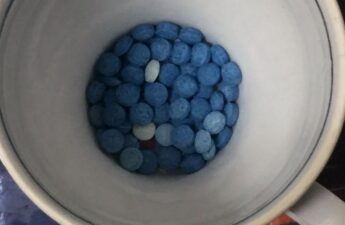Sarah Varney:
Insulin is a vital drug that some 7.4 million Americans must take daily to manage their diabetes.
But its price nearly doubled from 2012 to 2016, leaving some patients with no choice but to turn to black-market drugs or traveling to Canada, where insulin can be 90% cheaper.
KHN senior correspondent Sarah Varney reports in collaboration with PBS NewsHour about the skyrocketing cost of insulin — and the trend’s deadly consequences.
This is a transcript of the story:
Sarah Varney: It’s early morning in downtown Minneapolis, and Quinn Nystrom is scrambling to arrange last-minute logistics for the trip to Canada.
Woman: A little nervous out there.
Quinn Nystrom: You and me both.
Varney: The caravan has drawn the media’s eye to a vexing problem that threatens her life and other Type 1 diabetics in the U.S., the exorbitant cost of insulin.
They will cross five states, picking up passengers along the way, all to buy insulin in Canada, where it costs 90% less.
Nystrom: Does everybody have their passport? Is everybody holding their passport up?
Varney: For Nystrom, this quest began years ago, when she was growing up in rural Baxter, Minn. She was diagnosed with Type 1 at 13 and hated being different from other girls at school. But when her parents sent her to a camp for kids with diabetes, she learned she wasn’t alone.
Nystrom: I didn’t get the choice to get diabetes, but I certainly had the choice of how I was going to react to getting diabetes.
Varney: She had dreams of finding a cure for diabetes. But about five years ago, as she was starting her career in public relations, she realized the real crisis: the price of insulin.
Nystrom: When I went to pick up that insulin, it started costing me $200 out-of-pocket, then $300 out-of-pocket. So I just started posting that on my social media and started to get a lot of responses.
Varney: So, Nystrom, once her senior class president and self-described rule-follower, took a different path. She now expedites transfers of black-market insulin.
Nystrom: Thank you so much. This is perfect.
Varney: In her refrigerator is a drawer of insulin donated by good Samaritans. Even with insurance, Nystrom herself pays up to $600 a month for two to three vials of NovoLog.
Nystrom: I don’t care if somebody steals my TV, but if they steal my insulin, I’m in big trouble.
Varney: Between 2012 and 2016, the cost of insulin nearly doubled. Nystrom meets people online who can’t afford insulin, like Abigail Hansmeyer, who turned to this black market a decade ago.
And with a special-needs daughter and a tight budget, a trip to Canada isn’t an option.
Abigail Hansmeyer: There’s costs for gas, food, you know, if you’re needing to stay overnight at the hotel. It’s not a solution for everyone. People that work full time, have children, it’s not a feasible thing. And this is certainly a band-aid on the problem. And it’s not even a band-aid for everyone.
Varney: In Washington this year, lawmakers have grilled executives from the three main producers — Eli Lilly, Novo Nordisk and Sanofi — and investigated price-fixing. But, so far, no bills have passed.
In May, Colorado became the first state to cap monthly insulin copayments at $100. And, in Minnesota, people like Nicole Smith-Holt have pushed for legislation to provide free or low-cost emergency insulin.
Her son Alec, a Type 1 diabetic, died because he couldn’t afford the drug. We met Smith-Holt on the second anniversary of Alec’s death. Her family has made a memorial in their backyard. When Alec turned 26, he was no longer allowed on his mother’s insurance plan, and the restaurant he worked at didn’t offer any.
Nicole Smith-Holt: The lowest plan that we found was $450 a month with a $7,600 deductible. That’s really not affordable.
Varney: Instead, he decided to pay for his insulin over the counter at list price. But the pharmacist told him a month’s supply would be $1,300. With only $1,000 in his bank account, he left empty-handed.
When did you first get word that something had gone terribly wrong?
Smith-Holt: Five days later, I received a phone call from actually my mother, who received a phone call from his girlfriend. He wasn’t answering his door and he wasn’t answering his phone. She could hear the phone ringing in the apartment.
And she just happened — you know, checked one of his windows that happened to be unlocked, and she was able to climb in through his bedroom window, and she found him on his floor, cold and unresponsive.
Varney: Alec’s official cause of death was diabetic ketoacidosis, or DKA, when, without insulin, acid dangerously builds up in the bloodstream. DKA can occur when diabetics ration their insulin. A study found 1 in 4 do so because of cost.
Smith-Holt: I went through a stage where I felt extremely guilty, like I could’ve prevented it somehow, or I should have seen something, or I should’ve known something. It wasn’t long before, you know, my sadness turned into anger.
Varney: In the wake of Alec’s death, Smith-Holt began sharing her story.
Did you think at that point this — Alec’s story — had just been unique, that this had just happened to you?
Smith-Holt: Oh, yes, yes. I thought we were, like, the only ones. And I was reluctant to share the story at first, because I was, like, why would people want to hear, you know, our sad story about Alec passing away?
And now I know why. Every single Type 1 diabetic in the world can picture themselves in Alec’s situation.
Varney: Until prices come down in the U.S., people with Type 1 diabetes and activists like Smith-Holt are making these trips to Canada to stock up on insulin and call attention to the dramatic price difference.
Unlike in the U.S., the Canadian government and many other countries negotiate insulin prices with manufacturers. So they traveled through Wisconsin, Illinois, Indiana and Michigan, adding riders and cars to the caravan. Their reasons for joining were all personal.
Deb Souther: When I was 10 years old, I remember going to the pharmacy, and we bought a vial of insulin for $3. Now I’m paying $380.
Kristen Hoatson: I’m going for my son. He’s 11 years old. He’s had Type 1 diabetes for three years.
Varney: The trip is both practical and symbolic.
Nystrom: I don’t think anybody on this bus would have chosen to go on an 817-mile ride today, but we’re being forced to do this because we’re in a crisis in America.
Varney: In statements to the “NewsHour” and in public testimony, Eli Lilly, Novo Nordisk and Sanofi blame high-deductible insurance plans and payments to pharmacy middlemen for the out-of-pocket costs borne by patients.
For example, Sanofi said: “We believe lowering list prices alone will not necessarily result in lower out-of-pocket costs for most patients at the pharmacy. This is why we have not dropped the list price of our insulins.”
The companies all say they offer coupons and discounts to help defray the price of insulin. The patients we talked to said it was difficult to qualify for these assistance programs.
Some 16 hours later, the bus crosses the border to Canada, arriving well after midnight in London, Ontario.
Nystrom: We made it.
Varney: The next morning, the logistical problems continue for Nystrom. Multiple pharmacies have turned the group away, not wanting the media attention.
Nystrom: The insulin’s here. Let’s go and get it!
Varney: The group finally loads onto the bus and heads off to a local Walmart. At a pharmacy inside, one by one, they fill their prescriptions, some filming on their cellphones.
Nystrom: I can buy nine vials of this for significantly less than one vial.
Varney: The group spent about $2,000 for insulin. The same haul would cost almost $24,000 in the U.S.
To mark the end of the trip, they head to a spot revered by diabetes activists. It was here in London, Ontario, at this house that Dr. Frederick Banting first had the idea that led to the discovery of insulin. That was nearly 100 years ago.
Dr. Banting sold the patent for $1 to the University of Toronto. Pharmaceutical companies started manufacturing the drug that remained cheap well into the 20th century.
And, in Canada, insulin has stayed inexpensive. Nicole Smith-Holt says if she only knew she could have come here for Alec, she would have walked, crawled, done anything to save her son. And in a quiet, painful moment at the Banting house, she left some of Alec’s ashes.
For the “PBS NewsHour” and Kaiser Health News, I’m Sarah Varney in London, Ontario.


